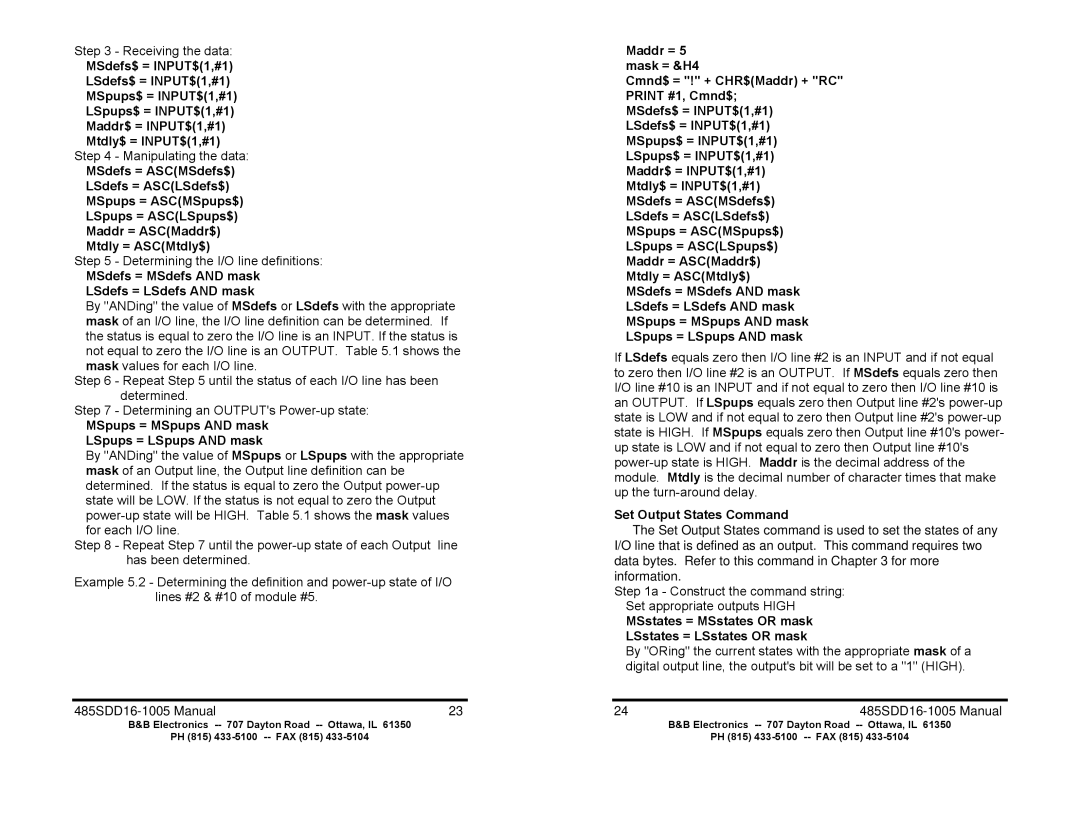Step 3 - Receiving the data:
MSdefs$ = INPUT$(1,#1)
LSdefs$ = INPUT$(1,#1)
MSpups$ = INPUT$(1,#1)
LSpups$ = INPUT$(1,#1)
Maddr$ = INPUT$(1,#1)
Mtdly$ = INPUT$(1,#1)
Step 4 - Manipulating the data:
MSdefs = ASC(MSdefs$)
LSdefs = ASC(LSdefs$)
MSpups = ASC(MSpups$)
LSpups = ASC(LSpups$)
Maddr = ASC(Maddr$)
Mtdly = ASC(Mtdly$)
Step 5 - Determining the I/O line definitions:
MSdefs = MSdefs AND mask
LSdefs = LSdefs AND mask
By "ANDing" the value of MSdefs or LSdefs with the appropriate mask of an I/O line, the I/O line definition can be determined. If the status is equal to zero the I/O line is an INPUT. If the status is not equal to zero the I/O line is an OUTPUT. Table 5.1 shows the mask values for each I/O line.
Step 6 - Repeat Step 5 until the status of each I/O line has been determined.
Step 7 - Determining an OUTPUT's
MSpups = MSpups AND mask
LSpups = LSpups AND mask
By "ANDing" the value of MSpups or LSpups with the appropriate mask of an Output line, the Output line definition can be determined. If the status is equal to zero the Output
Step 8 - Repeat Step 7 until the
Example 5.2 - Determining the definition and
| 23 |
B&B Electronics | 707 Dayton Road |
PH (815) | |
Maddr = 5 mask = &H4
Cmnd$ = "!" + CHR$(Maddr) + "RC" PRINT #1, Cmnd$;
MSdefs$ = INPUT$(1,#1)
LSdefs$ = INPUT$(1,#1)
MSpups$ = INPUT$(1,#1)
LSpups$ = INPUT$(1,#1)
Maddr$ = INPUT$(1,#1)
Mtdly$ = INPUT$(1,#1) MSdefs = ASC(MSdefs$) LSdefs = ASC(LSdefs$) MSpups = ASC(MSpups$) LSpups = ASC(LSpups$) Maddr = ASC(Maddr$) Mtdly = ASC(Mtdly$) MSdefs = MSdefs AND mask LSdefs = LSdefs AND mask MSpups = MSpups AND mask LSpups = LSpups AND mask
If LSdefs equals zero then I/O line #2 is an INPUT and if not equal to zero then I/O line #2 is an OUTPUT. If MSdefs equals zero then I/O line #10 is an INPUT and if not equal to zero then I/O line #10 is an OUTPUT. If LSpups equals zero then Output line #2's
Set Output States Command
The Set Output States command is used to set the states of any I/O line that is defined as an output. This command requires two data bytes. Refer to this command in Chapter 3 for more information.
Step 1a - Construct the command string:
Set appropriate outputs HIGH
MSstates = MSstates OR mask
LSstates = LSstates OR mask
By "ORing" the current states with the appropriate mask of a digital output line, the output's bit will be set to a "1" (HIGH).
24485SDD16-1005 Manual
B&B Electronics
PH (815)
